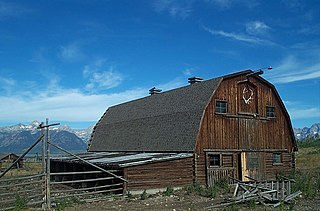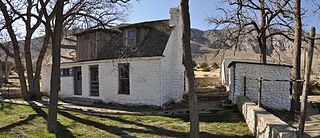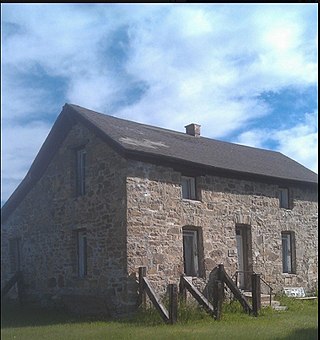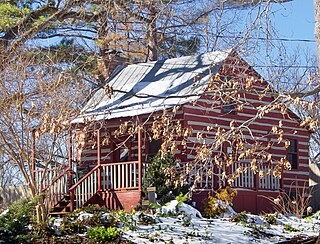
The Hunter Hereford Ranch was first homesteaded in 1909 by James Williams in the eastern portion of Jackson Hole, in what would become Grand Teton National Park. By the 1940s it was developed as a hobby ranch by William and Eileen Hunter and their foreman John Anderson. With its rustic log buildings it was used as the shooting location for the movie The Wild Country, while one structure with a stone fireplace was used in the 1963 movie Spencer's Mountain. The ranch is located on the extreme eastern edge of Jackson Hole under Shadow Mountain. It is unusual in having some areas of sagebrush-free pasture.

The James Cant Ranch is a pioneer ranch complex in Grant County in eastern Oregon, United States. The ranch is located on both sides of the John Day River in the John Day Fossil Beds National Monument. The ranch was originally homesteaded by Floyd Officer in 1890. Officer sold the property to James Cant in 1910. Cant increased the size of the property and built a modern ranch complex on the west bank of the river. The National Park Service bought the ranch from the Cant family in 1975, and incorporated the property into the John Day Fossil Beds National Monument. The National Park Service used the main house as a visitor center until 2003. Today, the Cant Ranch complex is preserved as an interpretive site showing visitors an early 20th-century livestock ranch. The James Cant Ranch is listed on the National Register of Historic Places.
This is a list of the National Register of Historic Places listings in Grand Teton National Park.

The historical buildings and structures of Grand Teton National Park include a variety of buildings and built remains that pre-date the establishment of Grand Teton National Park, together with facilities built by the National Park Service to serve park visitors. Many of these places and structures have been placed on the National Register of Historic Places. The pre-Park Service structures include homestead cabins from the earliest settlement of Jackson Hole, working ranches that once covered the valley floor, and dude ranches or guest ranches that catered to the tourist trade that grew up in the 1920s and 1930s, before the park was expanded to encompass nearly all of Jackson Hole. Many of these were incorporated into the park to serve as Park Service personnel housing, or were razed to restore the landscape to a natural appearance. Others continued to function as inholdings under a life estate in which their former owners could continue to use and occupy the property until their death. Other buildings, built in the mountains after the initial establishment of the park in 1929, or in the valley after the park was expanded in 1950, were built by the Park Service to serve park visitors, frequently employing the National Park Service Rustic style of design.

The Frijole Ranch, also known as Guadalupe Ranch, Spring Hill Ranch and the Rader-Smith Ranch, is located in Guadalupe Mountains National Park in extreme west Texas. It was listed on the National Register of Historic Places on November 21, 1978, and represents a significant period in the settlement and ranching of the Guadalupe Mountains.

The Patrick Rodgers Farm, or Rodgers Ranch, is a historic home and ranch located in Pleasant Hill, California. In 1991, the property was listed on the National Register of Historic Places.

The Old Borges Ranch is a 1,035 acres (419 ha) historic district in the Mt. Diablo foothills within the 2,600-acre (1,100 ha) Walnut Creek Open Space in Contra Costa County, California. A former cattle ranch, Old Borges Ranch includes multiple historic buildings, a ranger station, farm animals, and access to trails.
The Sims-Garfield Ranch is a site on the National Register of Historic Places located near Ryegate, Montana. It was added to the Register on August 27, 1980. The listing included six contributing buildings:
The Walter Cliff Ranch District, at 7635 Old HW 395 in Washoe Valley, Nevada is a historic site that was listed as a historic district on the National Register of Historic Places in 1985. It has significance dating from c.1870, when the house was built. The listing included two contributing buildings: the house and a root cellar/residence building.

The Frey Ranch, at 1140 W. Peckham Ln. near Reno, Nevada, dates from 1870, when a 240 acres (97 ha) ranch was founded. A 1 acre (0.40 ha) site of its main house, including Late Victorian architecture, survives. It was listed on the National Register of Historic Places in 1999; the listing included three contributing buildings.

Hoskins House Historic District, also known as Tannenbaum Park, is a historic log cabin and national historic district located at Greensboro, Guilford County, North Carolina. The Hoskins House is a late-18th or early-19th century chestnut log dwelling house measuring 24 feet by 18 feet. It has an interior enclosed stair and exterior stone chimney. The house was restored in 1986–1987. Also on the property is the contributing Coble Barn. It is a large double-pen log barn of hewn V-notched logs under a long wood-shingled gable roof. The barn was moved to and restored at its current location in 1987. The Hoskins House site was the focal point of the British attack during the Battle of Guilford Court House on March 15, 1781. The Hoskins property survives today as an important satellite to the Guilford Courthouse National Military Park.
The Broad View Ranch Historic District is a nationally recognized agricultural historic district located northwest of Sheldon, Iowa, United States. It was listed on the National Register of Historic Places in 1994. At the time of its nomination it contained 19 resources, which included nine contributing buildings, one contributing site, four contributing structures, and two non-contributing structures.

The Bath Ranch, also known as the Bath Brothers Ranch and the Stone Ranch, was established near Laramie, Wyoming by Henry Bath about 1869-70. It was one of the first ranches in Albany County. The initial homestead was replaced by the present stone house and barn in 1875, using stone quarried locally by Henry and his sons. Since the area was populated by hostile Native Americans, the buildings were designed as fortified refuges. The Bath family became prominent in Wyoming society in subsequent years.
The Flying Horseshoe Ranch was established in the Centennial Valley of southeastern Wyoming by Danish immigrant Mads Wolbol in the late 1870s. The complex of mostly log structures, about 15 of which are considered contributing structures.

The Pleasant Lawn School Historic District is a nationally recognized historic district located northeast of Mount Pleasant, Iowa, United States. It was listed on the National Register of Historic Places in 1987. At the time of its nomination it consisted of three resources, all of which are contributing buildings. This is the only intact example of a consolidated rural school district in Iowa. It consists of a two-story brick school building (1917), a two-story frame teacherage (1917), and a hack barn. A gymnasium was added to the school building in 1941. The school was still in existence when the buildings were added to the National Register.

Eagar Townsite Historic District is a section of the town of Eagar, Arizona which has been designated a National Historic Place. Sitting on roughly 54 acres, the site contains 37 structures, 21 of which have historical significance. The period of significance is from 1886, the year the townsite was founded, through 1942, which represents the significant period of development of the town. The site was added to the Register on July 23, 1993.
The Gramberg Ranch, in Pennington County, South Dakota near Hermosa, was listed on the National Register of Historic Places in 1999. The listing included eight contributing buildings, six contributing structures, and four contributing sites.

Crawford's Experiment Farm, in Williston, Tennessee, was listed on the National Register of Historic Places in 1991. The listing included three contributing buildings and a contributing structure.
Stewart Ranch, also known as Stewart-Hewlett Ranch, near Woodland, Utah in Wasatch and Summit counties, includes eight buildings which were separately listed on the National Register of Historic Places in 1985. The former ranch is located off Utah State Route 35. Some or all of the ranch is included in what is now the Diamond Bar X Ranch.













